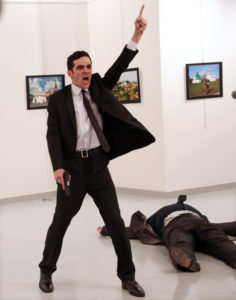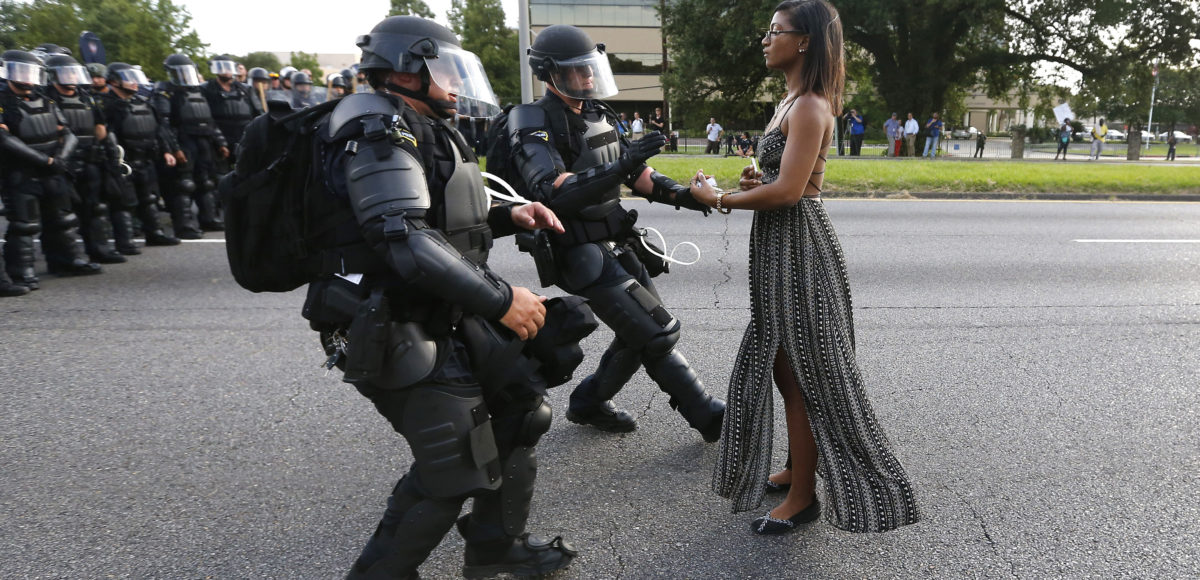Even in the age of ubiquitous video, a still image can be explosive, as seen in the World Press photo of the year.
The photograph, now in the World Press photos of the year exhibition at the Canadian War Museum, will be familiar to anyone who’s paying any attention to the news of this unsettled world. In it, an off-duty Turkish police officer stands over the dying Russian ambassador, Andrey Karlov, who lies motionless on the floor of an art gallery, where he had been giving a speech likely of the tediously scripted sort so often heard around official Ottawa, and which would have immediately been forgotten on any other day. The assassin holds in one hand the pistol he had just used to shoot Karlov, and he raises his other hand and, reportedly, shouts in Arabic and Turkish, “God is great. Don’t forget Aleppo. Don’t forget Syria.” Moments later, he was shot dead by Turkish special forces.
A video of the shooting may be available, but its relentless forward motion would make the action seem transitory, fleeting. The still image has the power of permanence. It freezes the most dramatic moment — not when the bullet was fired into the unwitting ambassador, but when the assassin stood by his dying victim to shout his cause, fully aware he’d be shot down within minutes or seconds. It can be said that both men died for their beliefs, but the assassin intentionally sacrificed himself to his cause, and whatever the viewer’s position on that cause, the knowledge of that imminent sacrifice gives this moment — the hand raised, the final, fatal expostulation — an intense dramatic depth.

Mevlut Mert Altintas shouts after shooting Andrei Karlov, right, the Russian ambassador to Turkey, at an art gallery in Ankara, Turkey, Monday, Dec. 19, 2016. At first, AP photographer Burhan Ozbilici thought it was a theatrical stunt when a man in a dark suit and tie pulled out a gun during the photography exhibition. The man then opened fire, killing Karlov. Photo: Burhan Ozbilici Associated Press
The annual exhibition is administered and toured by the World Press Photo Foundation, which says on its website that, “Freedom of information, freedom of inquiry and freedom of speech are more important than ever, and quality visual journalism is essential for the accurate and independent reporting that makes these freedoms possible.”
The dozens of photographs are a stark reminder of how fleeting such freedoms can be, and how the struggle for them never ends — though more in some places than in others. The exhibition exposes the uncomfortable dichotomy of modern life where, still, much of the world is torn by oppression and slaughter, while the rest plays sports and other pastimes.
In Afghanistan, a woman holds her nephew, who was injured in the car-bomb blast that killed his sister, and together they look like a modern re-enactment of Michelangelo’s sculpture The Pietà, of Mary holding the body of Jesus. In another, an 11-year-old Nigerian girl comforts her younger brother after they were rescued from the middle of the Mediterranean Sea. “Their mother had died in Libya, after crossing the Sahara,” the caption says.
There are no images of Canadian events, but the survey is global. In the United States, a black woman stands straight and strong before a squadron of heavily armoured police officers in Baton Rouge, at a rally to protest yet another police shooting of an unarmed black man.
The nature photos offer scant relief from conflict. A loggerhead turtle floats in a tangle of green fishing net, which beautifully, perversely, complements the blue waters. A leopard stalks darkened alleys in suburban Mumbai in search of prey, and risks human contact and its regrettable outcome.
The best sports photographs are more exhilarating. A tennis player dives for a forehand. Sprinter Usain Bolt crosses the finish line and looks back, smiling, at the other runners who are, like every other human on the planet, slower. Most spectacular, jockey Nina Carberry flies through the air after her horse fell on a jump during the Grand National Steeplechase in the United Kingdom. The caption reveals that, astonishingly, no horse or rider was injured. Yet, surely, human and equine egos were bruised.
Such lighter moments are few, yet in those moments and in the others — those violent, terrifying others — the power of the still image is affirmed. It, like the global fight for freedom, goes on.
The World Press photos exhibition of the year runs from July 21 to Aug. 13 at the Canadian War Museum.






